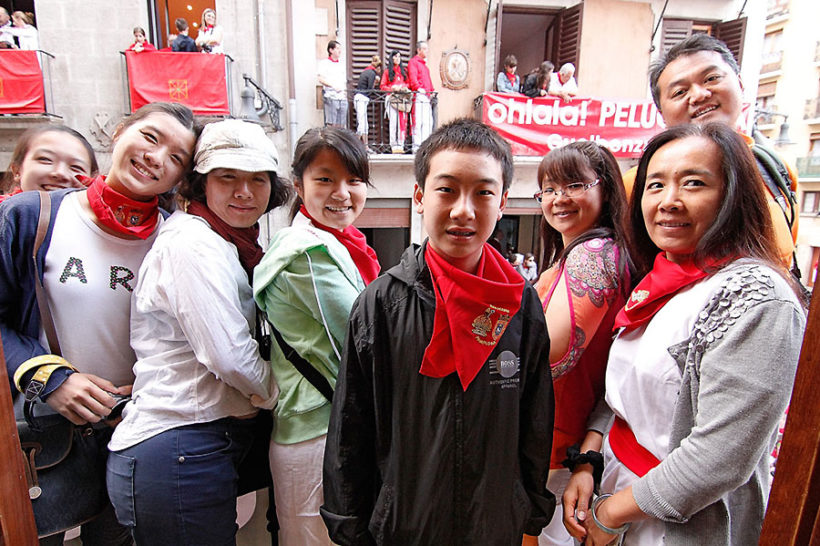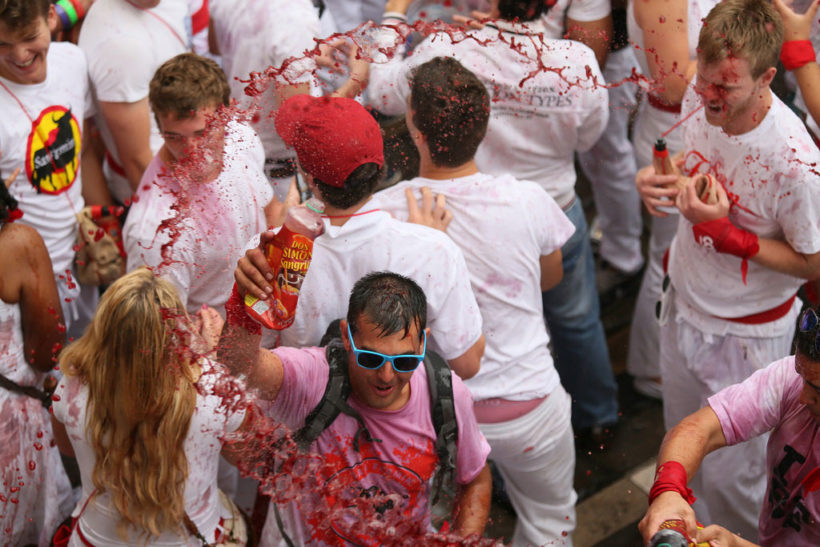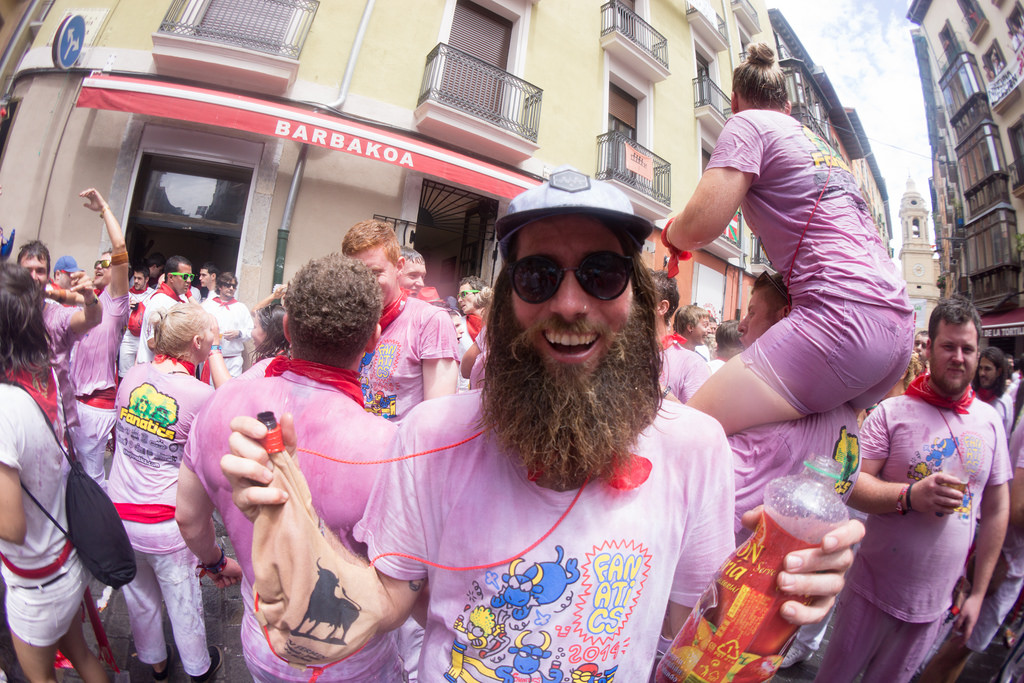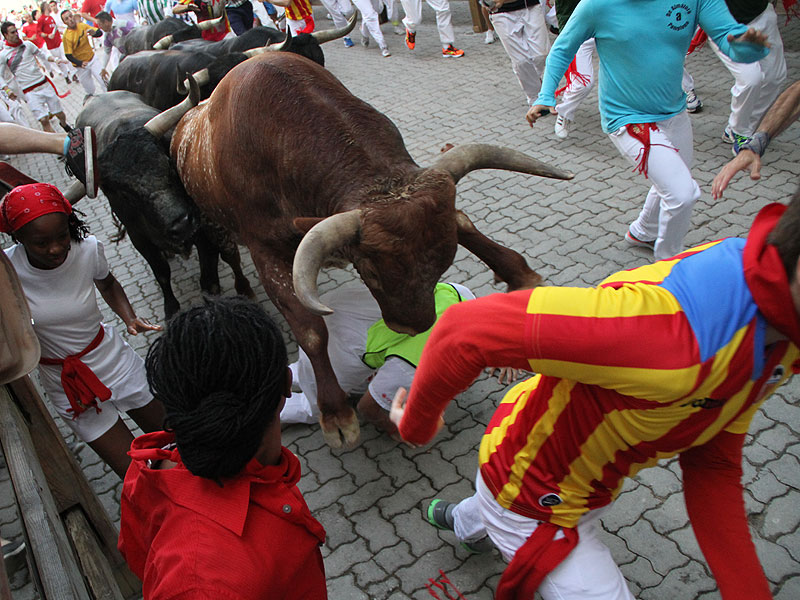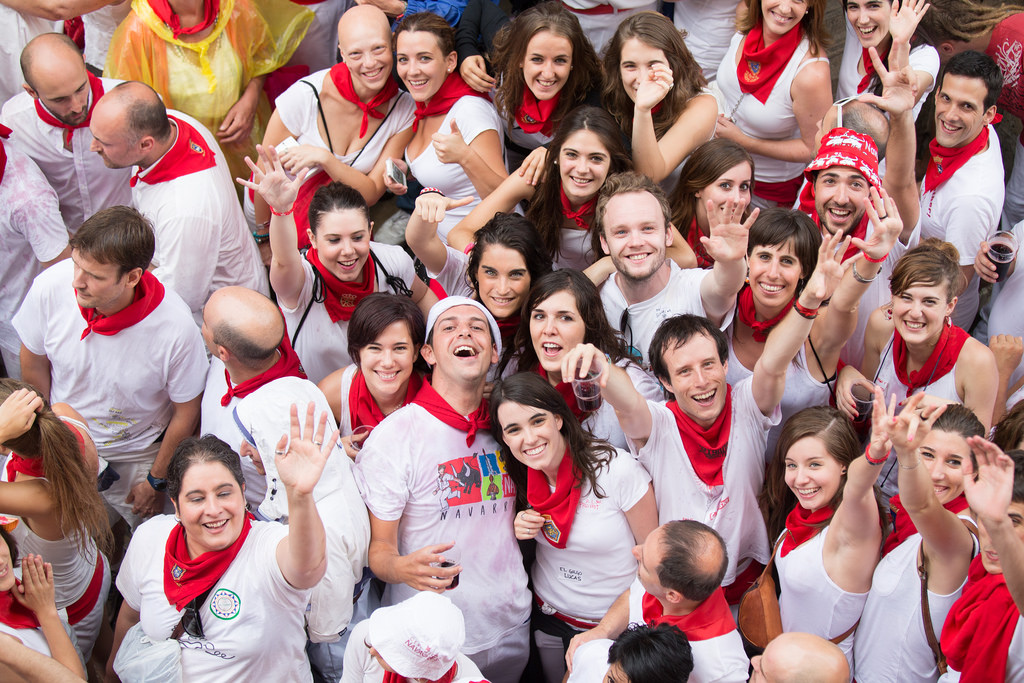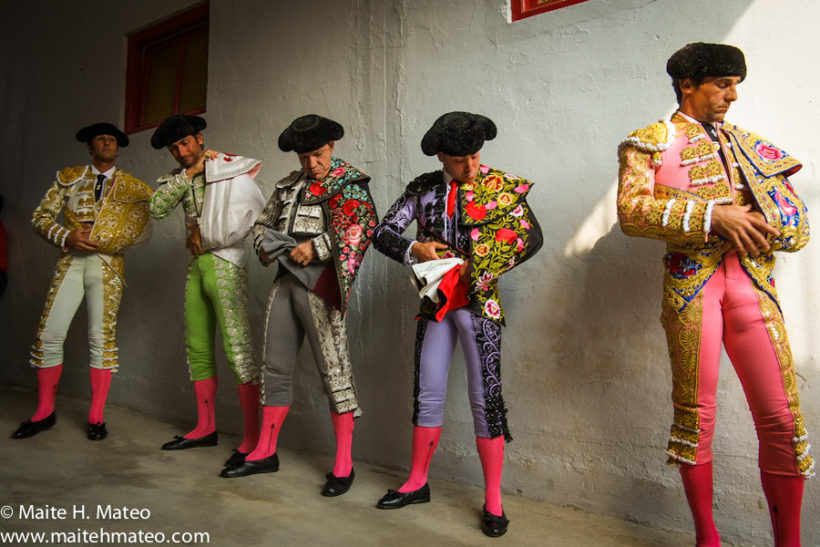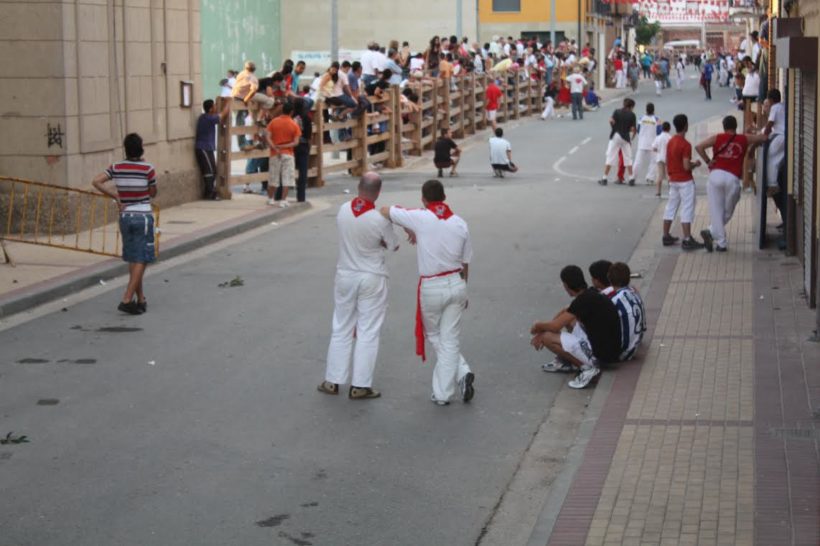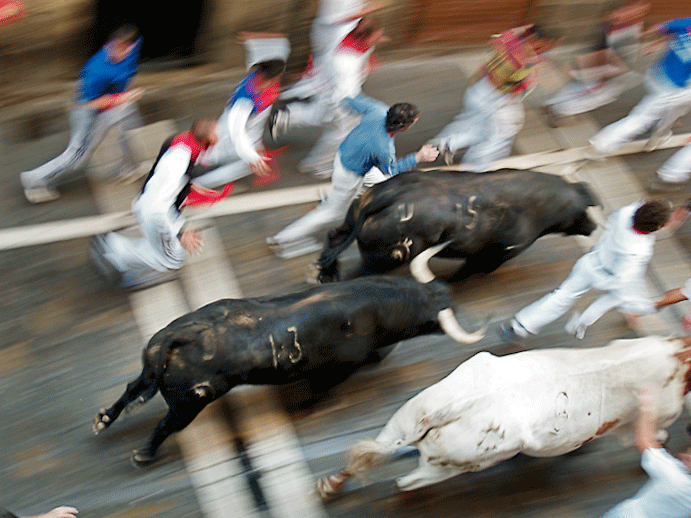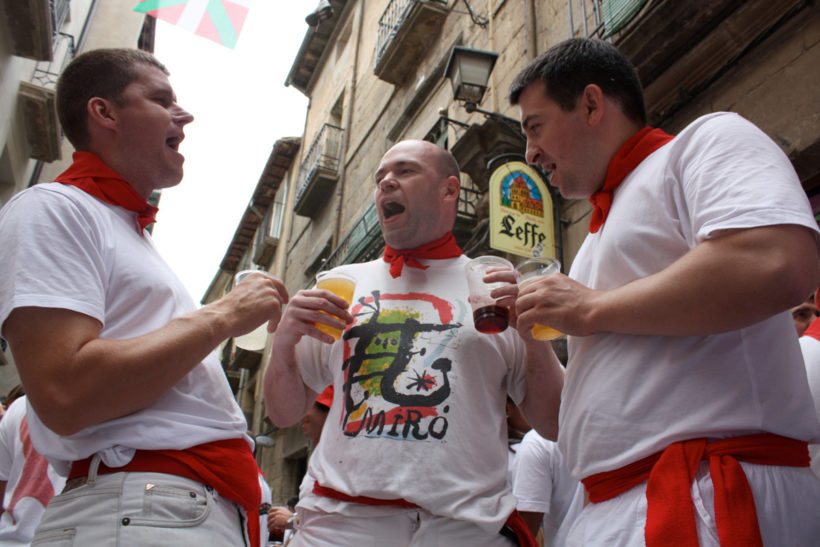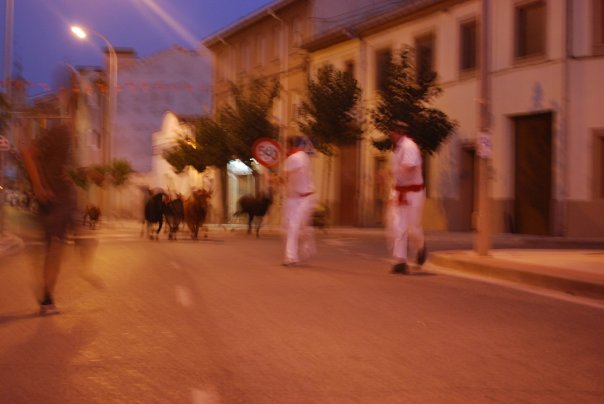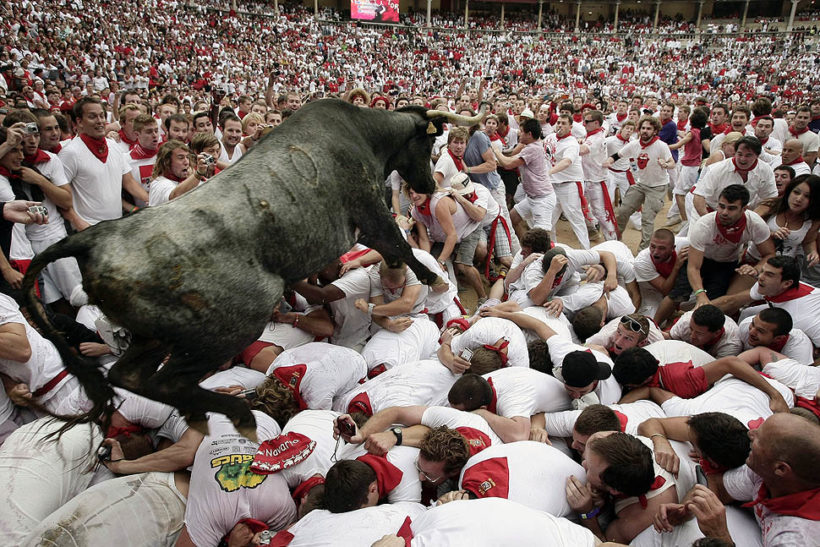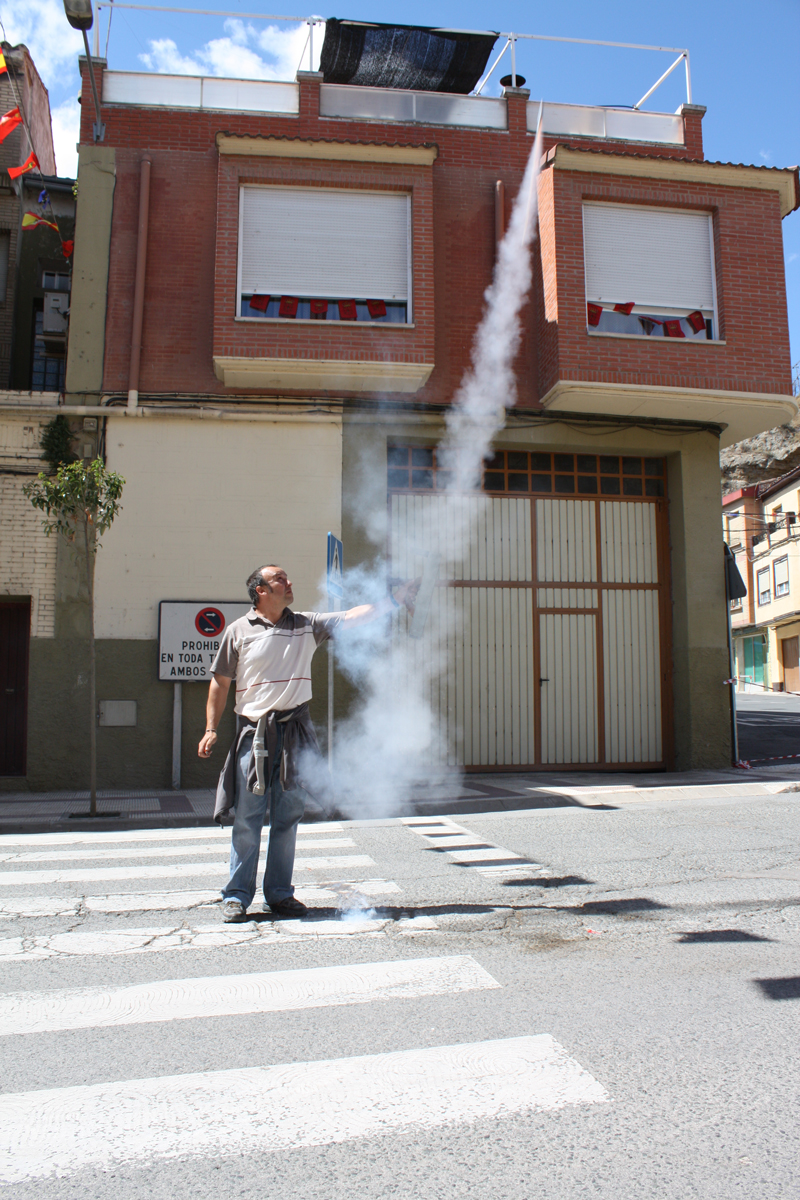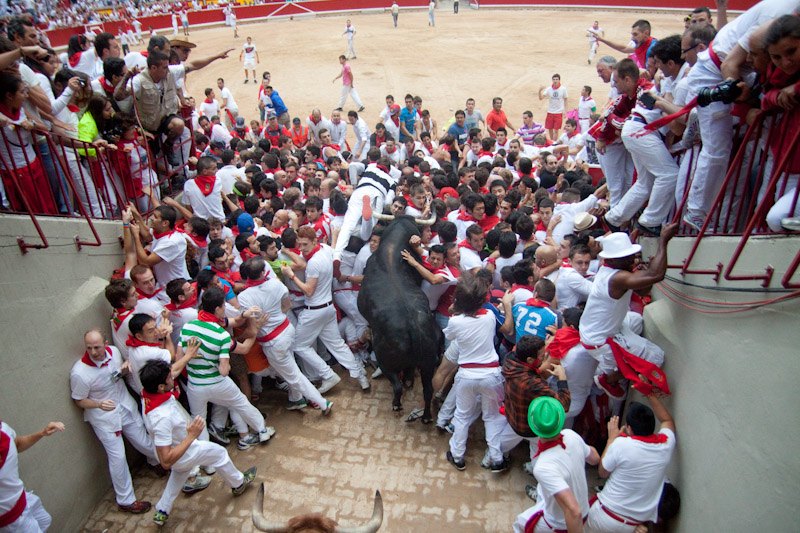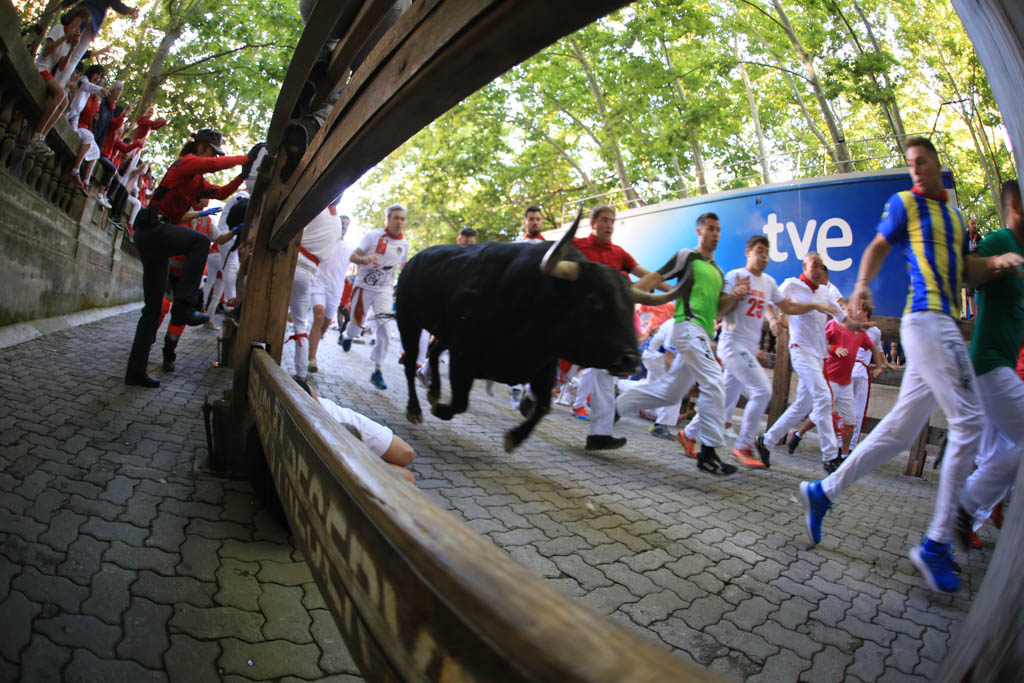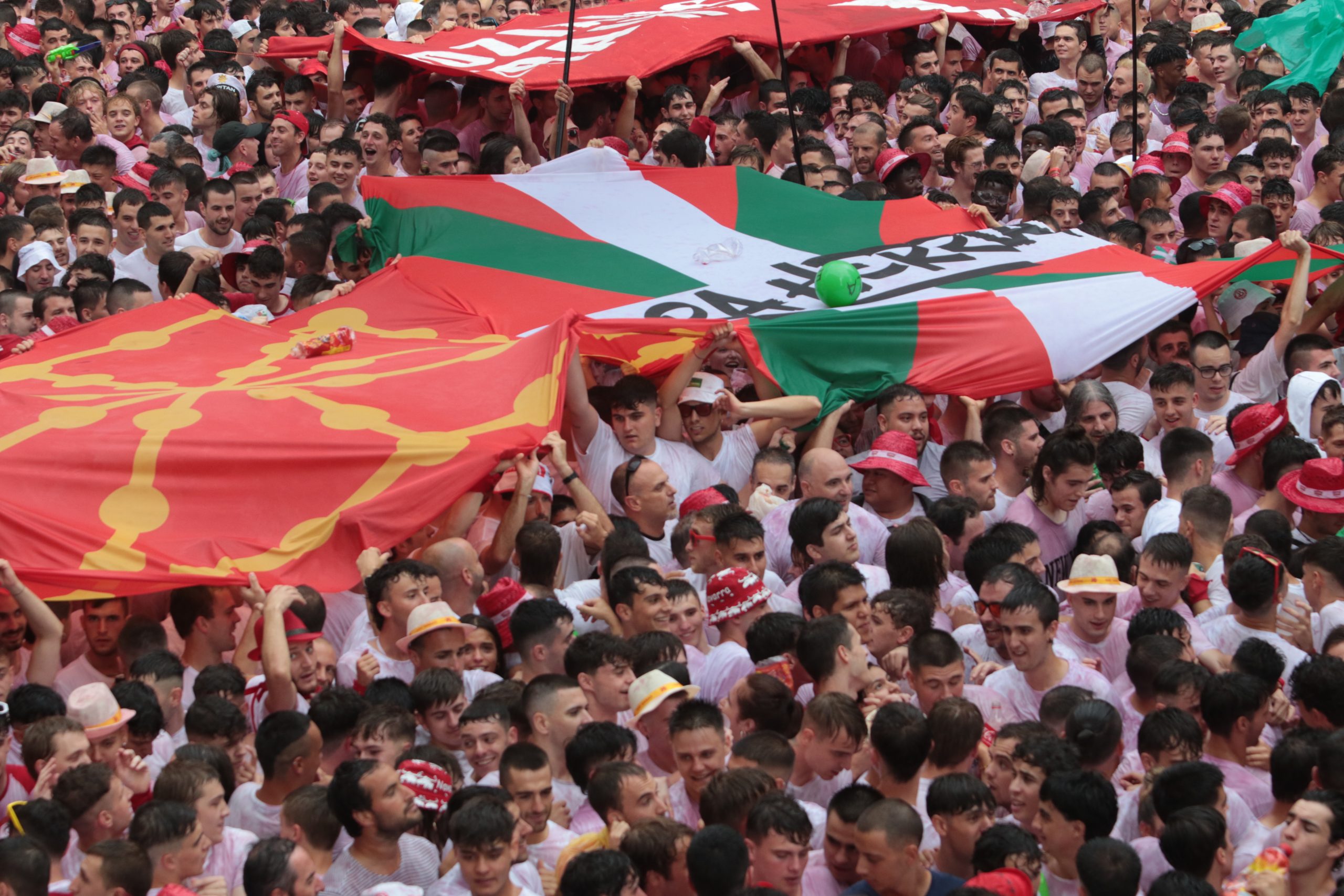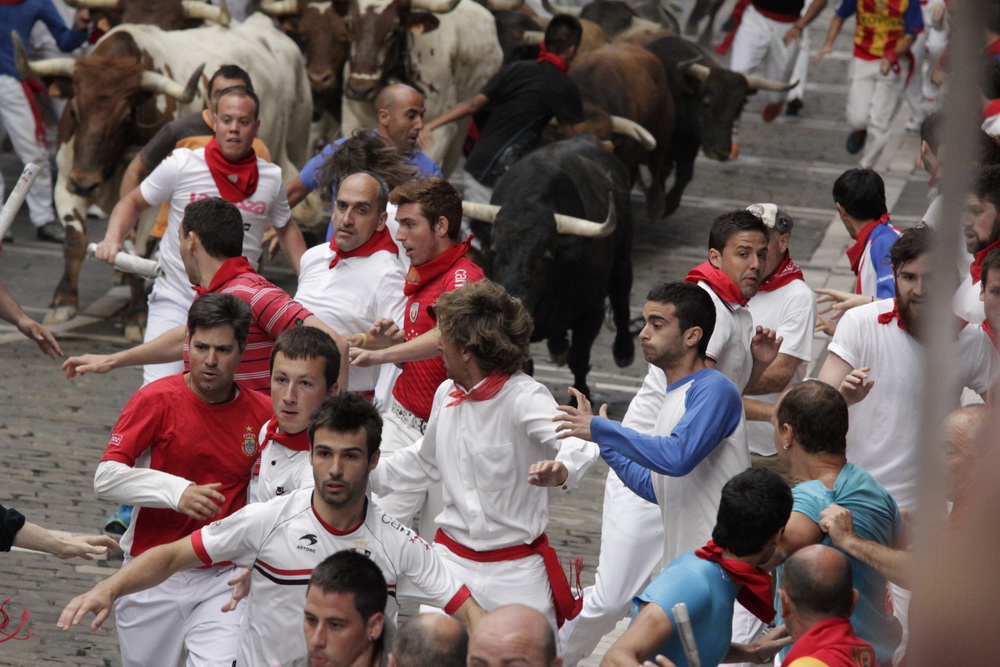Image: Miguel Goñi
Billseye
by Tim Pinks
The chap in the superb photo below, for those who don’t know him, is Bill Hillman, and he wrote something about one of this years runs that I thought was just so good it needed to be seen.
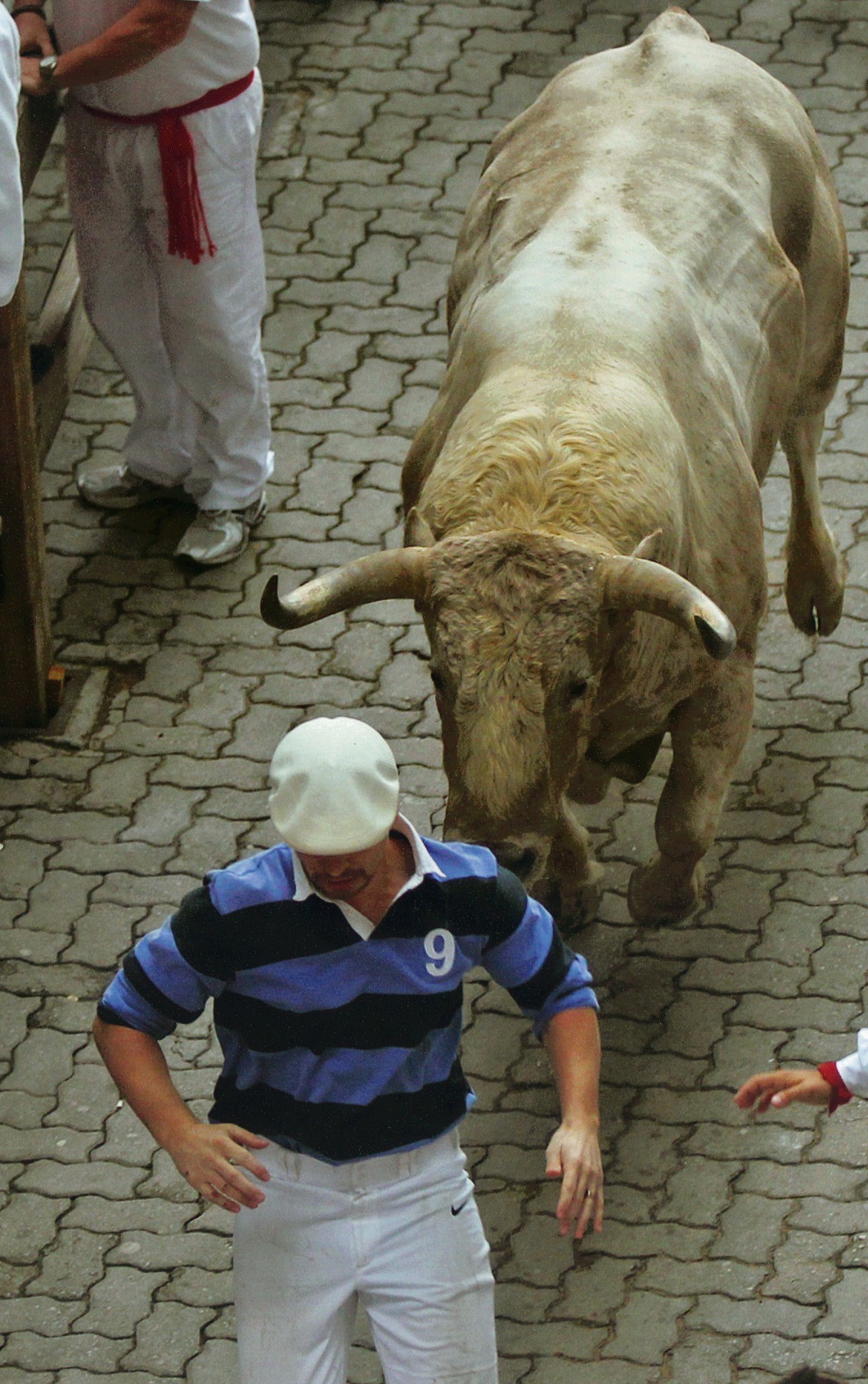
As those of you who read this more or less monthly series of articles knows, I almost always prefer to write about anything else but myself. But this month I’m going even further, as not only am I not going to blow my own trumpet, but I’m going to use this space to blow someone else’s. The remarkable piece below isn’t even written by me, but by the above mentioned Bill Hillman, one of the “new” generation of bull runners, and a very good one at that.
Although there is slightly more to the article than that, because he was actually running that morning as the dramatic events unfolded, and he gives what for me is a real skin-tingling account of what he experienced. I think it’s an excellent piece, and parts of it, as mentioned, for personal reasons which I wont go into here, left me shaking. As I say, Bill wrote the article, but I’ve furnished it with the pictures. Hope you don’t mind, Bill. Take it away, maestro.
SLEEPERS
By Bill Hillman
There’ve been many deadly human pile ups in the history of Pamplona ’s bull run. This year a pile up hospitalized 23 people and left one battling for his life.
On July 13th it was the Fuente Ymbro bulls’ turn to run the streets of Pamplona and I was happy because they were noble and majestic and I always ran well with them. I left early from my starting position at the last section of the course like usual and was striding cleanly in the center of the street with good vision of the herd as they approached. Three galloping black bulls lined up in a loose string with Aitor, the best young Spanish mozo running the lead animal. Aitor strode in his tall, long gate in front of the snout of the muscular animal?man and beast in perfect synch. Aitor’s white hoodie with black and red stripes fluttered as I matched their pace and approached, shoulder-to-shoulder with him.
As I cruised beside Aitor a woman tripped in front of him. He started to fall and I surged in and swung my paper behind his back and swatted the bull’s horns to attract him away from goring Aitor. Aitor dropped to the stones and I led the bull and ran in front of his horns. We merged into one speeding force before the tunnel into the arena.
As I stepped into the tunnel a small pile-up of five people tripped me. I tried to leap it and fell flat on my belly. The bull ambled on. I crawled to the two-foot tall opening that lines the bottom of the tunnel and slipped inside. The room is large and empty.
Suddenly screams volleyed in from the tunnel and a powerful roar of horror exploded into the dark room. Dozens of runners flew in through the low opening. I reached down and pulled them in. Suddenly Aitor’s striped sleeve appeared and I yanked him through and to his feet. The inflow of bodies stopped but the dread continued. I got down on my belly to look out. A regal white bull sat at the opening of the tunnel in quiet meditation. At the entrance to the ring a horrific mountain of people jams the path into the arena. Then the white bull climbed to his hooves. The runners in the tunnel scrambled.
I decided I should go out and try to help if I could. The white bull gets up and trots into the pile. I crawled back out into the tunnel and finally clearly saw the hundred or so white and red clad people crushed in the opening to the arena. Twelve gigantic bovine are stacked atop them in the center. The white bull turned and I panicked and nearly jumped out through the slot on the other side of the tunnel, but he didn’t attack. None of them did. They were afraid and the fear mysteriously calmed them instead of igniting them to rage.
Then something gives way and the blockage breaks. I helped Josecho nearly close the red metal doors and then followed him in. Regretfully I stepped over the fallen bodies. Then I was onto the sand of the ring. The bulls vanished. I went back to the unraveling pile and pulled people out until they all scrambled away. Underneath it I found a scattered pile of tennis shoes and five slumbering men. Their faces were swollen like big red tomatoes slowly turning blue. All of their mouths were agape but none of them seemed to be breathing. I looked up and the herd materialized and circled the arena dumbfounded.
Afraid that the bulls will return and finish off the unconscious men, I grabbed one of them by the arm and drug him away. It looks like someone bludgeoned his head with a baseball bat. Others appeared and we picked him up and tried to give him to a Policía Foral. The officer only yelled at us and waved his baton in our faces. We put the sleeper down on the white sand. I looked at him and knew he was very bad. His face was bluish-purple and he was clearly dying.
A mozo with a colorful shirt yelled and picked him up. I helped carry him and we cross the ring. A Red Cross medic appeared and I screamed “¿Dónde?” in his face and he pointed. We crossed the ring. There’s an erratic electricity that exudes from the dying; it ejected sparks out into my hands and numbed them as we crossed the ring. The life inside him undulated and surged under his skin warm in my hands. Suddenly I was exhausted and nearly fell as we approached another tunnel.
With the last of my strength we carried him through a door up a flight of stairs. A stretcher flung out of a doorway at the top and we put him down unconscious and purple with his mouth urging for air. As I turned to leave they carried two more in behind him?both asleep and looking very grave. A pale young man gored under his arm walked in?his shirt torn, wet and red. His eyes are wide and strangely placid.
More “Forales” appeared. They push all of us away including the gored young man. I yelled “¡Cornada!” and point at the goring. And I think he got in before the one in the colorful shirt put his arm around me and led me away. I tried to make sense of it all as I climbed out trembling and remembering the way his blood gushed and convulsed under his skin like the life was running scared to escape.
As I got outside I realized I had to find my wife and I ran down to our place and buzzed and they said she was looking for me at the arena. I ran down to Bar Txoko and they said she was just there and I rounded the corner and there she was. I took her in my arms and she throbbed and cried and we held each other in a doorway for a long time. Then she finally calmed and smacked me across the face for scaring her and we laughed, she still doesn’t understand why I do this. As my friends appeared safe and healthy I remembered why I run and we all hugged a lot at Bar Txoko.
Then someone told me they’d screwed up with the doors and I sat with my head in my hands and wondered if the young man was dead.
Later I found out his name was Jon Gerónimo Mendoza, a 19 year old from Vitoria Spain . He’d fallen in the pile up and the many people and the immense, six ton herd crushed his chest and suffocated him. He was in a coma and on life support at the local hospital, most people gave him a slim chance of survival.
As I watched the footage of the run I realized that it was partially caused by a man in charge of one of the doors into the ring. He’d opened it to let some of the “Forales” in so they could line the ring walls and batter anyone who misbehaved. There was a huge swell of valientes (runners who run before the bulls arrive) as the door opened the valientes pried the gate ajar and that set the stage for the terrible. I remembered trying to hand the “Forales” John Jeronimo’s limp body and him waving his baton in my face. I recalled wanting to punch him square in the jaw and I wished I had. Then I saw a video of another Policía Foral carrying one of the sleepers by himself and stopped blaming them.
But there was more to it all than some mistake at the gateway. The pile already started in the tunnel when the door opened. The Valientes caused it. These uninformed first time runners often cause folly on the course. Many of them are American tourists who’ve done no research or people who are half drunk with no sleep, no knowledge, going on rumor and stupidity.
For the past six years I’ve given two bull-run tours a day for first-time runners, teaching them the basics, warning them on the dangers and giving them practical advice on how to react and plan their run. I can’t help but wonder if enforcing some sort of mandatory certification for first time runners could have at once reduced the number of people on the street that morning and avoided the chaotic pile up all together. I wish I’d had a chance to say something to Pamplona about it. Some way to voice my idea and offer to help.
After over 24 hours on life support Jon Gerónimo miraculously woke up from his coma and began to speak. The bull-run I love dodged a major catastrophe but if nothing changes I fear for the future of Pamplona ’s legendary run.
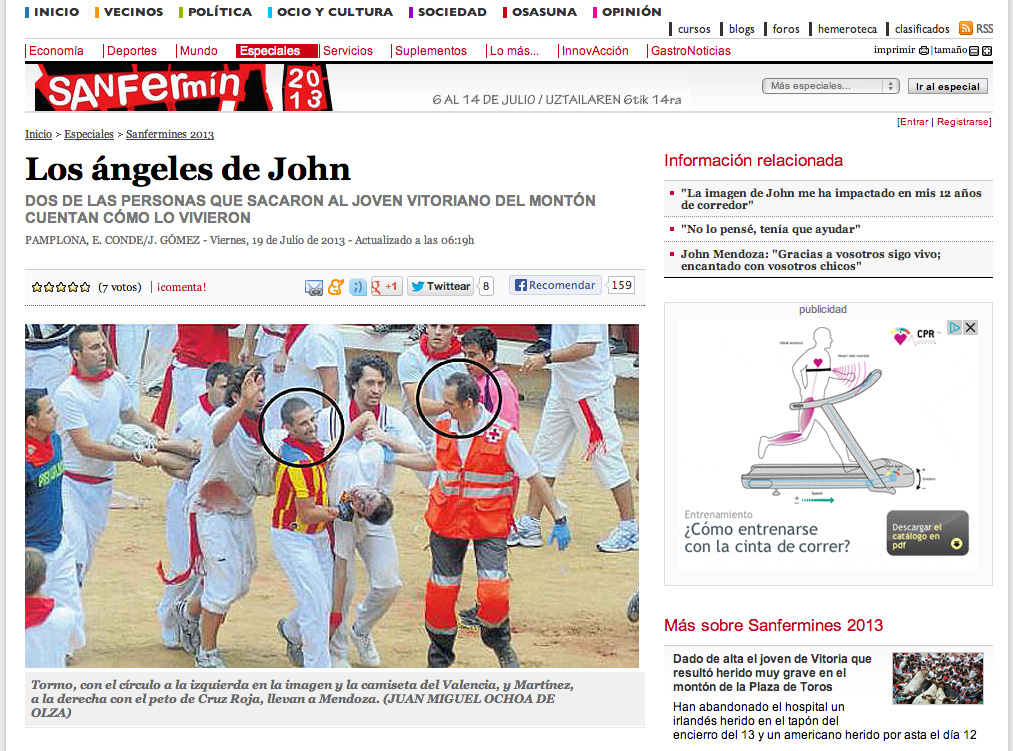
Tim Pinks again…
Wow, Bill. No matter how many times I read it, I still shake at the same parts. Enhorabuena, my friend.
The photo above, by the way, shows Bill amongst other runners carrying the seriously injured (yes, actually, dying) Jon Gerónimo Mendoza Ruiz to the bullring infirmary. He’s the one between the two people circled. The article is about how Jon’s father has called his rescuers “angels.” Well, if that was your son, brother or friend, you would, wouldn’t you? Jon Mendoza, by the way, is making what the doctors have called an amazing recovery, and is doing okay, although there will be a couple of months before he completely recovers, I understand.
Oh, and “angels?” I understand completely Jon’s Dad calling them that, but I don’t think Bill for one moment would describe himself thus, but I do know one thing…if I was in trouble, he is exactly the sort of human being I’d want covering my back. He’s one of the good guys.
For those of you who don’t know, Bill Hillman is from Chicago and has been coming to San Fermin since 2005, although he had to miss 2007. He has ran the bulls in Pamplona 59 times and so has only missed a very few runs. If you include runs he has done in Sanse (San Sebastian de los Reyes) and Cuellar then it brings it up to 63 runs.
His debut fictional novel, “The Old Neighborhood” is out next April, to be published by Curbside Splendor, and he happily admits his writing has been influenced by Hemingway. Well, that’s not a bad start start, is it?
Thanks again Bill for the article, it is, in parts, a truly emotional and haunting read. Describing those badly injured people as “sleepers” is something that will stay with me forever.
To end, a video of that day. But as many of us have seen the television and bullring filming of what happened that morning, here’s coverage from a mobile phone taken that morning. Scary stuff.
Ya falta mucho, everyone…but ya falta menos.
Tim Pinks

